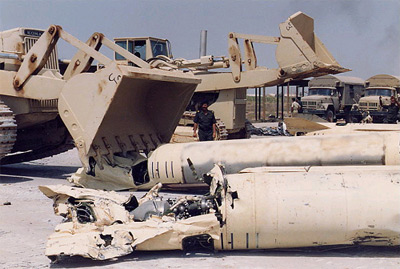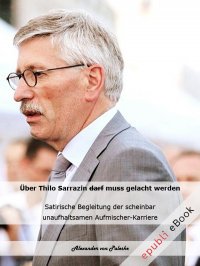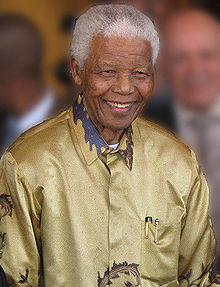Saddam's WMDs and Russia / Part I
The nuclear weapons program was never abandoned by the regime, and before the first Gulf War (1991) Iraq was very close to producing its own nuclear weapons. (There is some evidence that Saddam could have purchased nuclear technology from Pakistan, through Dr. Khan’s network, and that he has tried to buy nuclear weapons or components from China). The war destroyed the technical base for the production. But the highly skilled scientific and technical personnel (over 200) remained in place, dispersed. The regime managed to save their nuclear fuel, many technical means of production and the blueprints of the nuclear weaponization.

Russian-made SCUD missiles, launched against the Coalition forces and/or against Israel, proved inaccurate in aim and ineffective.
The after-war international (UN) control proved ineffective. Iraq also saved an essential part of its biological and chemical warfare technology, materials and personnel. Some of the WMDs, materials, specialists from Iraq have been transferred abroad to continue research and to organize the production abroad: mainly to Sudan, Libya and Algeria but also to the neighboring Syria (with a purpose to strengthen Syrian regime’s offensive capabilities against Israel).
Saddam regime's WMD policy after the 1st Gulf War
The efforts of the Saddam’s regime to preserve and develop its biological, chemical and even nuclear weapons capabilities have been well documented in a report, submitted to the U.S. House of Representatives by Yossef Bodansky on February 10, 1998 (See: Task Force on Terrorism & Unconventional Warfare, "The Iraqi WMD Challenge — Myths and Reality"). From the very beginning, Saddam Hussein embarked on a policy of concealment and cheating of the UN inspection. Thus the elimination of the Iraqi strategic military programs and the destruction of their technical means have never been completed and fully effective. "Despite Baghdad’s protestations, Iraq does have a small but very lethal operational arsenal of WMD and platforms capable of delivering them throughout the Middle East and beyond." — summarized Yossef Bodansky in 1998 [page 2 of the report].
This capability was possible due to the following actions:
Iraq was also capable to develop new types of offensive weapons, capable of carrying and dispersing bio and chemical WMDs (like a plastic-plywood drone, range 700 km, GPS navigation system, carrying 30-40 kilograms of bio or chemical warfare agents, launched from the ground, aircraft or from a ship).
The Bodansky report also concludes that the Saddam regime has signed agreements with Sudan, Libya, Algeria about common ventures in the developing of biological, chemical and nuclear weapons. These were Saddam’s investments into the future, though his decisions were reluctant and taken under the pressure of the UN inspections and American bombing of Iraq’s "no fly" zones.
The role of the Russians
The first Gulf War (1991) proved a complete failure of the Soviet conventional weapons systems on the Iraqi battlefields. The Iraqi Army and Air Force had been crushed before they could make use of their WMDs (chemical, biological). The Russian-made SCUD missiles, launched against the Coalition forces and/or against Israel, proved inaccurate in aim and ineffective.
In spite of the huge indebtedness of the Iraqi regime to Russia (over US$ 8.0 billion), the Russian Government decided to invest a new service into the rebuilding of the Iraqi military forces by supplying large quantities of spare parts, components, air-defenses equipment, worth at least US$ 1.0 billion. Secret agreements, signed between the Iraqi Intelligence and the Russian GRU, provided for a "clean up" operation, conducted by Russian and Iraqi military personnel, to remove some WMDs, materials for production, technical documentation etc. from Iraq, so that the Saddam regime could announce that Iraq was "WMD free". This operation began after the 1991 Gulf War and lasted until weeks before the outbreak of the 2nd war (March 19-20, 2003).
Author's own experience with the Iraqi procurement of WMDs
In the early 1990s, the author witnessed a massive illegal "export" of previously top secret nuclear materials, components and weapon parts from Russia and other ex-USSR countries to intermediaries and "end users" in Europe, Asia and America. But no sooner than in Winter of 1992, he became involved in an international monitoring operation of these illegal deals.
His decision to take part in it, was the result of a meeting in Jerusalem, in February 1992, with a longtime friend, an Israeli nuclear expert, the late Mr. Shalheveth Freier. One of the main routes of the illegal nuclear trade went through Poland to Germany, Austria, Britain, Switzerland, France and other countries of Western Europe. A number of nuclear (radioactive) materials was offered from the former USSR countries (including weapons-grade uranium and plutonium).
It was a very lucrative business for Russian and other military and intelligence people and for the mafia organizations.
At least two times, the author (posing as an international trader) has been approached by members of the
These materials were available from Russia through intelligence and military connections, but the Russian contacts always demanded information on the potential "end users" of these products. The first contact was in 1993, and the Palestinian intermediaries were working for Iraq and Libya. The deal required a sophisticated logistic support and security arrangement. The Iraqi customer was ready to receive and purchase the Russian nuclear products in Western Europe (Austria, Switzerland) and the Libyan customer demanded that the stuff be shipped by air from Russia, directly to Libya. The Russians (GRU) were capable to carry out such an operation. Iraqi intelligence operatives would also use Jordanian intermediaries (Palestinians) and point to a false-flag "end user", like "the King of Saudi Arabia".
When a Polish security service began to trace the Abu Nidal’s envoys in Poland, they moved to Kiev in the Ukraine and continued their procurement of nuclear materials from Russia. A new transaction was scheduled for Spring of 1994, with a place of delivery in Switzerland. The author "coordinated" it from Paris, in France. Details about the Abu Nidal’s group were filed to Israel and to the CIA Station in Paris.
Another Palestinian (from al-Fatah) approached the author in 1996, looking for nuclear materials under "the King of Saudi Arabia" false flag. The source of the material was in Moscow, in a special military plant and laboratory. This time, the Russians could not easily organize the secret transport of goods abroad, due to the enhanced security measures in Russia and Poland. The author learned, later on, that the Palestinian intermediaries in Amman dealt with members of the Iraqi Intelligence. The connection was reported to a U.S. diplomatic contact.
It was interesting, however, that the al-Fatah member was sent to the author by a former head of the Polish National Security Council (name withheld but known), who owned a joint venture company with an Iraqi national residing in Poland. Later on, his company got a squeeze from the Polish security and counter-intelligence agency (UOP) but nothing had been found, apart from evidence of the company’s efforts to obtain a license for military exports (which has been refused to it). The Russian side of the deal was the GRU, as previously. Was it a Polish or an Israeli "sting operation"?
There is no doubt, however, that (in accordance with the Yossef Bodansky report to the House, in 1998), the Saddam regime never resigned from searching for nuclear materials, in spite of the ever tighter controls imposed on Iraq by the UN inspectors.
But it is even more interesting that the author received a report (from Israel), after the 2d Gulf War, stating that the Iraqi regime had purchased a large quantity of RM 20/20 and some Russian ADM’s (Atomic Demolition Munitions). As to the RM 20/20, it might be transferred to Libya or to Syria. But the ADMs were under Spetsnaz control, and certainly were withdrawn by Russians from Iraq before March 19-20, 2003.
sfux - 10. Okt, 08:01 Article 2938x read
















































